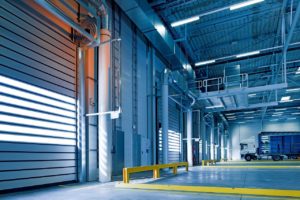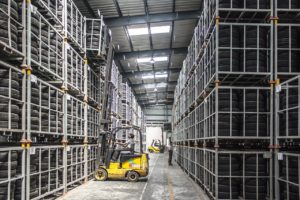health & safety lighting
The importance of lighting in industrial spaces
While plenty of attention is paid to access, hygiene and cleanliness, with companies appreciating the importance of providing safe passage for workers and vehicles, clearing up any spillages promptly, and offering clean facilities, too many firms underestimate the impact their lighting strategy has on health and safety. That’s according to Ken Eddleston, Lighting Product Manager at Chalmit.
In this article, Ken will explore the factors decision-makers should consider if they want to develop a lighting strategy that is mindful of health and safety.
Temperature
 Working conditions that create dusty, flammable or explosive atmospheres require a lighting design that doesn’t emit too much heat. This is crucial because in potentially explosive atmospheres, if the maximum surface temperature of a light exceeds the rated temperature, it will in all likelihood ignite the combustible gases and/or dust present in the environment. To prevent this from happening lighting should also be able to operate spark free.
Working conditions that create dusty, flammable or explosive atmospheres require a lighting design that doesn’t emit too much heat. This is crucial because in potentially explosive atmospheres, if the maximum surface temperature of a light exceeds the rated temperature, it will in all likelihood ignite the combustible gases and/or dust present in the environment. To prevent this from happening lighting should also be able to operate spark free.
While it is difficult to control the temperature of fluorescent and incandescent light bulbs, this is not the case with LED lights. Instead, LED lights are known for remaining cool, often being constructed with robust and durable heat sinks. Heat sinking increases the surface area and allows for maximum air flow for heat to dissipate and transfer from the light to the ambient environment. Effective thermal management in lighting protects the people and equipment that surround it, ensuring workers aren’t put in danger of accidents or even fatalities.
Maintenance
Lighting strategies must also consider the importance of system lifetime. Long-life lighting reduces the downtime, costs and risks associated with maintenance work in industrial and hazardous environments. Installing durable lighting will enable companies to withstand the challenges present in such environments. For instance, the lighting must be able to cope with corrosive elements in water and air, continuous vibrations, shocks and fire risks. Fluorescent and incandescent light bulbs often fail to reach their predicted lifespan when installed in such environments, mainly because of their moving parts, which include unstable filaments that are vulnerable to damage.
Performance
 Workplace safety can be improved with highly directional and uniform lighting that has good colour rendering. High precision tasks in industrial environments, such as quality checks and reading gauge measurements, mustn’t be carried out in dimly lit conditions. Good lighting reduces the risk of slips, trips and falls, and safety can be particularly enhanced by utilising good quality lighting in process areas, compressor decks, stairwells, catwalks and walkways, all of which need to be illuminated consistently.
Workplace safety can be improved with highly directional and uniform lighting that has good colour rendering. High precision tasks in industrial environments, such as quality checks and reading gauge measurements, mustn’t be carried out in dimly lit conditions. Good lighting reduces the risk of slips, trips and falls, and safety can be particularly enhanced by utilising good quality lighting in process areas, compressor decks, stairwells, catwalks and walkways, all of which need to be illuminated consistently.
When comparing the performance of luminaires across both traditional and LED lighting, the focus should be on the usable light on the work plane determined by the lux reading. Decision-makers shouldn’t simply compare different lumen scores as, given its more directional nature, LED lighting requires fewer lumens than traditional light sources while performing even better. LED lighting has specialised optics that can deliver the output of a much larger linear light, generating a bright, white output over a desired area.
Efficiency
In addition, lighting efficiency has an impact on safety. Essentially, more efficient systems enhance safety by reducing the load on the electrical system.
LEDs use far less energy when compared to fluorescent alternatives. For luminaires across all lighting sources, both input wattage and lumens are documented, and a calculation of lumens per watt functions as the efficiency metric. Drivers are used to power LEDs. They have very high-power factors (PF) and low total harmonic distortion (THD). The most efficient lights will perform with a PF above 95% and a THD below 15%.
Conclusion
The safety of workers should always be the number one priority for companies. In fast-paced industrial environments, the focus can often move away from safety towards product or service, but the importance of protecting people and assets should never be superseded. After all, up to 40% of businesses never recover from major interruptions or disasters.
Plant managers and engineers are facing safety concerns owing to frequent lighting failures in the face of extreme temperatures, explosive gases, combustible dust and fibre, high pressure water hosing, vibration and corrosive fluids. With this in mind, it is important to carefully think about your lighting strategy. Invest in lighting that provides compelling safety benefits.
The importance of lighting in industrial spaces
A look at some of the factors decision-makers should consider if they want to develop a lighting strategy that is mindful of health and safety.
Safety & Health Practitioner
SHP - Health and Safety News, Legislation, PPE, CPD and Resources Related Topics
Almost half of UK manufacturing employers have increased spending on workforce health and wellbeing
Bedding manufacturer fined after employees suffer serious injuries
Manufacturing company fined £300k after worker’s finger amputated

 Working conditions that create dusty, flammable or explosive atmospheres require a lighting design that doesn’t emit too much heat. This is crucial because in potentially explosive atmospheres, if the maximum surface temperature of a light exceeds the rated temperature, it will in all likelihood ignite the combustible gases and/or dust present in the environment. To prevent this from happening lighting should also be able to operate spark free.
Working conditions that create dusty, flammable or explosive atmospheres require a lighting design that doesn’t emit too much heat. This is crucial because in potentially explosive atmospheres, if the maximum surface temperature of a light exceeds the rated temperature, it will in all likelihood ignite the combustible gases and/or dust present in the environment. To prevent this from happening lighting should also be able to operate spark free. Workplace safety can be improved with highly directional and uniform lighting that has good colour rendering. High precision tasks in industrial environments, such as quality checks and reading gauge measurements, mustn’t be carried out in dimly lit conditions. Good lighting reduces the risk of slips, trips and falls, and safety can be particularly enhanced by utilising good quality lighting in process areas, compressor decks, stairwells, catwalks and walkways, all of which need to be illuminated consistently.
Workplace safety can be improved with highly directional and uniform lighting that has good colour rendering. High precision tasks in industrial environments, such as quality checks and reading gauge measurements, mustn’t be carried out in dimly lit conditions. Good lighting reduces the risk of slips, trips and falls, and safety can be particularly enhanced by utilising good quality lighting in process areas, compressor decks, stairwells, catwalks and walkways, all of which need to be illuminated consistently.
Good work lighting essential in either work or office space with some UV-C, for good measure, to make-up for lack of day lighting augmenting bacterial control. Maybe at the tipping point for the 58% of DSE operators too with Accessibility issues being considered prior to returning to the office although, equally applicable to working from home if employers wish to recover 20% lost productivity due to visual repetitive stress injuries (Asthenopia / WRULD’s, MSD’s) simply resulting in operators “carrying-on regardless” self-harming and presenteeism until the stress related adaptations reach the point of exhaustion and, predictable “consequential ill-health” enforces a prolonged… Read more »